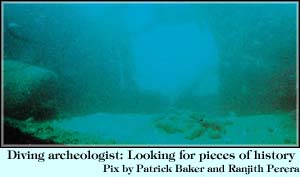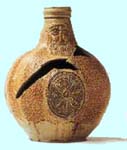 |
 4th April 1999 |
Front Page| |
History under waterBuried in centuries of sands Galle's shipwrecks may shed new light on our ancient links. Udena R. Attygalle reports:
The Avonstar was one of the fascinating sights we came upon when The Sunday Times team went out on a diving expedition with the members of Sri Lanka's first maritime archaeological project last week. It all began in 1992 when on the invitation of eminent local archaeologist Prof. Senaka Bandaranayake, a team from the Western Australian Maritime Museum (WAMM)came to Sri Lanka to introduce the then relatively new concept of marine archaeology to the Department of Archaeology. Today the project has come a long way. Funded mostly by the local department, for a few weeks each year a team from Australia carries out archaeological research here and trains local archaeologists. With plans to develop the Galle harbour being accepted in 1995, a complete survey and rescue of archaeological artefacts is underway . A conservation laboratory, the first of its kind in the island, is being built by the Archaeological Department to preserve the artefacts. Unfortunately very few artefacts can be brought up until the lab is fully functional. Surrounded by salty waters for centuries, the alien environment on land would cause the artefacts to deteriorate, and then a part of history could be lost forever. With work on the laboratory coming to an end, Tuesday March 23 was the first day of serious diving to bring up artefacts.We found the site, originally located on information provided by local fisherfolk, using transits. Back in 1992 the most important sources of information on wreck sites had been the local fisherfolk. Once a site was located its position was accurately recorded. The 1996 season saw equipment like side scan sonars being used for the surveys. The southern command of the Sri Lanka Navy provides a lot of assistance to the maritime archaeology project. They provide the boats for the diving expeditions. Led by Karen Miller the diving team that Tuesday included Palitha, Rukshan and Daya three of the eight local divers trained in 1997. After spending hours in the water plotting and documenting they brought up baskets replete with stunning items from the Avonstar, which included a part of a wooden barrel very well preserved. The finds seem to indicate that trade was the primary task of this doomed vessel. Palitha said he had come to be a part of the project as an archaeology undergrad at the Kelaniya university. Today he is a PADI -a qualified diver working for the Archaeology Department. Unable to dive we could only imagine the eerie splendour of the wreck below, through a camcorder and the camera lens of Patrick Baker, the maritime archaeology photographer. Only the ship's anchor was dimly visible from the surface. The ship is buried deep in sand. The Avonstar is not alone on the sea bed of the Galle harbour. There are four more identified and well documented wrecks in the vicinity. They include the Dutch ships ,the Hercules, Dolfijn and Barbesteijn and the Geinwens. The Avonstar, however, is the more complete of these wrecks. Says Patrick, "Protecting these wreck sites from treasure hunters is extremely important." The fate of our archaeological sites on land seem to echo his concern. The Hercules wreck site includes a number of cannons. Unfortunately bringing these relics of ancient artillery up for conservation with limited resources is a Herculean task. After the sites were discovered exhaustive research was done by Robert Parthesius and Lodewijk Wagenaar from the Amsterdam Historical Museum, both at the Sri Lanka National Archives and the archives in Amsterdam. The combination of shipwreck archaeology and archival information on the harbour and shipping provided an opportunity for both a general study about trade and shipping and a detailed study of the ships wrecked in the Galle port. Conservation work comes next. It is at this stage that ambiguous items are cleaned, and artefacts discovered!
Not only the fragile coil of rope but even solid rock anchors have to be treated properly, if they are to be conserved. Salt if allowed to dry out would result in artefacts chipping away. After removing calcareous marine growths and hardened sediments using scalpels and dental tools, these have to be saturated in fresh water till all the salt is taken out. This procedure may sometimes take upto six years. As with all artefacts regular inspections must be carried out to determine whether any problems are developing. "When the lab is ready we hope to get school children involved in the conservation work," said Jon. This it is hoped, will go a long way in generating interest about marine archaeology among the youth of the country. Indranee Fernando of the conservation section of the Archaeological Department who had been trained by Jon said she was happy to have learned much of a branch of conservation about which hitherto she and her local colleagues knew very little.
Shipwrecks all aroundThe 'Galle public awareness programme', sponsored by the Royal Netherlands Embassy with the assistance of the Archaeological Department was inaugurated on March 26. With the initial results of the work done so far, the programme includes a permanent exhibition at the National Maritime Museum in Galle, the first of its kind in the island, and a tour through the historic Galle fort. Galle may well only be the beginning for this ambitious project With legends abounding of shipwrecks all around the island's coasts, further investigations could shed light on our own seacraft, and our own proud history. But it may also trigger the menace of the present, treasure hunting and vandalization of our heritage. If the latter happens, the work of this team may prove to be ephemeral, and we may never know a part of our history that lies deep under the waters of the Indian ocean. |
||
 |
Front Page| News/Comment| Editorial/Opinion| Business| Sports | Mirror Magazine |
|
 |
Please send your comments and suggestions on this web site to |
|
 Faintly
visible underwater, a mere five metres below, buried in the distant history
of three hundred and forty years of sand lies the Avonstar, a Dutch ship
that met its doom just yards away from the shoreline of ancient Galle.
Faintly
visible underwater, a mere five metres below, buried in the distant history
of three hundred and forty years of sand lies the Avonstar, a Dutch ship
that met its doom just yards away from the shoreline of ancient Galle. Till
the laboratory is complete, work is being carried out at the hotel where
the team is based, under the guidance of Jon Carpenter senior archaeological
conservator from the WAMM. Among the artefacts found are cups , pots, old
pipes, wine bottles (some with good wine inside!), doctors' equipment (a
container containing mercury inside was found), a coiled rope and even
parts of a brick fireplace aboard the ship.
Till
the laboratory is complete, work is being carried out at the hotel where
the team is based, under the guidance of Jon Carpenter senior archaeological
conservator from the WAMM. Among the artefacts found are cups , pots, old
pipes, wine bottles (some with good wine inside!), doctors' equipment (a
container containing mercury inside was found), a coiled rope and even
parts of a brick fireplace aboard the ship.